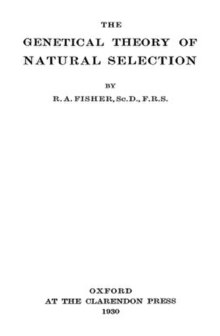 First edition title page | |
| Author | Ronald Fisher |
|---|---|
| Language | English |
| Subject | Evolutionary biology |
| Publisher | The Clarendon Press |
Publication date | 1930 |
| Publication place | United Kingdom |
| OCLC | 18500548 |
| 575.423 | |
| LC Class | QH366 .F5 |
| Preceded by | Statistical Methods for Research Workers |
| Followed by | The Design of Experiments |
The Genetical Theory of Natural Selection is a book by Ronald Fisher which combines Mendelian genetics with Charles Darwin's theory of natural selection,[1] with Fisher being the first to argue that "Mendelism therefore validates Darwinism"[2] and stating with regard to mutations that "The vast majority of large mutations are deleterious; small mutations are both far more frequent and more likely to be useful", thus refuting orthogenesis.[3] First published in 1930 by The Clarendon Press, it is one of the most important books of the modern synthesis,[4] and helped define population genetics. It had been described by J. F. Crow as the "deepest book on evolution since Darwin".[5]
It is commonly cited in biology books, outlining many concepts that are still considered important such as Fisherian runaway, Fisher's principle, reproductive value, Fisher's fundamental theorem of natural selection, Fisher's geometric model, the sexy son hypothesis, mimicry and the evolution of dominance. It was dictated to his wife in the evenings as he worked at Rothamsted Research in the day.[6]
- ^ Edwards, A. W. F. (April 2000). "The Genetical Theory of Natural Selection". Genetics. 154 (4). Bethesda, MD: Genetics Society of America: 1419–1426. doi:10.1093/genetics/154.4.1419. ISSN 0016-6731. PMC 1461012. PMID 10747041.
- ^ The Structure of Evolutionary Theory (2002) by Stephen Jay Gould, Chapter 7, section "Synthesis as Restriction" Gould quotes Fisher “The whole group of theories which ascribe to hypothetical physiological mechanisms, controlling the occurrence of mutations, a power of directing the course of evolution, must be set aside, once the blending theory of inheritance is abandoned. The sole surviving theory is that of Natural Selection” The Genetical Theory of Natural Selection (1930, p. 20)
- ^ The Structure of Evolutionary Theory (2002) by Stephen Jay Gould, Chapter 7, section "Synthesis as Restriction" Gould further quotes Fisher “For mutations to dominate the trend of evolution it is thus necessary to postulate mutation rates immensely greater than those which are known to occur, and of an order of magnitude which, in general, would be incompatible with particulate inheritance” The Genetical Theory of Natural Selection (1930, p. 20)
- ^ Grafen & Ridley 2006, p. 69
- ^ Ford, E. B. (2005). "R. A. Fisher: An Appreciation". Genetics. 171 (2): 415–417. ISSN 0016-6731. PMC 1456759. PMID 16249595.
- ^ "Sir Ronald Aylmer Fisher". History of Statistics & Probability. Minneapolis, MN: University of Minnesota. Retrieved 2015-11-25.